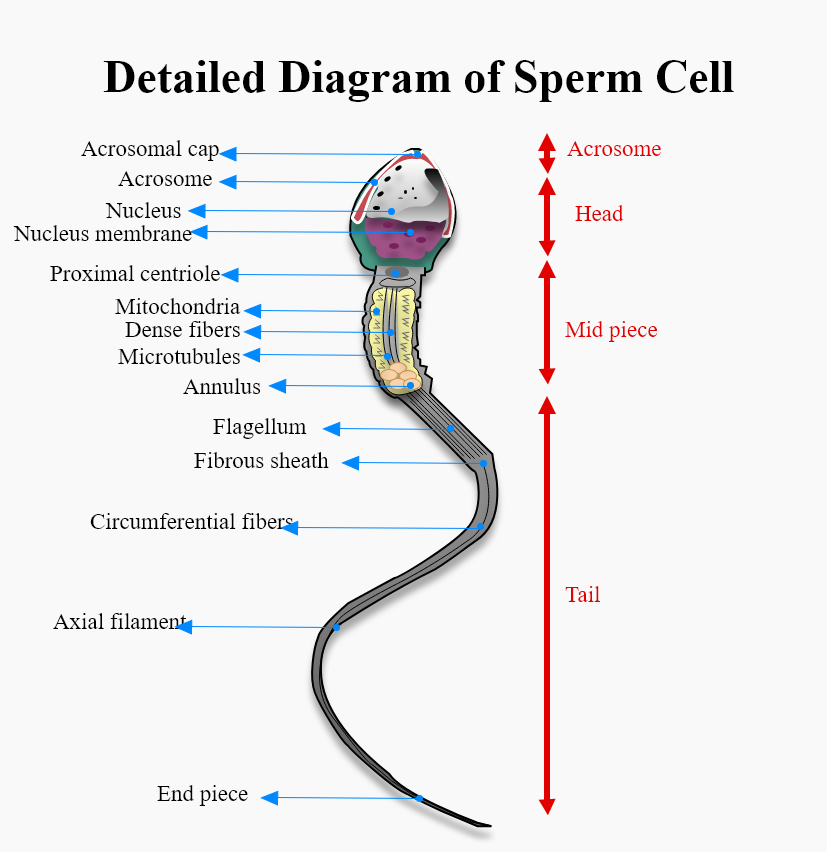
(a). Draw an electron microscopic view of mammalian sperm. Label any six internal structures of the sperms?
(b). What do you call the area of an ovum from where the sperm makes its entry?
(c). Name the enzyme produced by the sperm to facilitate its entry.
(d). List any two events taking place in an ovum just when sperm gains entry into it.
(e). How does the entry of the sperm influence cell division of the secondary oocyte?
Answer
456.6k+ views
Hint: In higher vertebrates, especially mammals, it is produced in the testes. It unites with (fertilizes) an ovum (egg) of the female to produce a new offspring. It has two distinguishable parts, a head, and a tail. It contains only 23 chromosomes or half of the usual number.
Complete answer
(a).

(b) The sperm makes its entry into the ovum by binding to the corona radiata of the ovum and formation of the cone of attraction through which the spermatozoa enter.
(c) Hyaluronidase is the enzyme that helps the sperm to penetrate the corona radiata during fertilization.
(d) Cortical reaction and capacitation are two events happening in an ovum just when sperm gains entry into it.
(e) The secretions of acrosome help the sperm enter into the cytoplasm and cell wall of an ovum. This induces the completion of the meiotic division of secondary oocyte which is unequal and results in the formation of a second polar body and ootid.
Additional information
Sperm, also called spermatozoon, plural spermatozoa, male germ cell, produced by most animals. With the exception of nematode worms, decapods (e.g., crayfish), diplopods (e.g., millipedes), and mites, sperm are flagellated; that's, they need a whiplike tail.
The head of the sperm varies in shape for every animal species. In humans, it is flattened and almond-shaped, four to five micrometres long and two to three micrometers wide (there are about 25,000 micrometres in an inch). The head portion is especially a cell nucleus; it consists of genetic substances, called chromosomes, which are liable for transmitting specific characteristics of a private, like the color of eyes, hair, and skin. In each body cell of healthy humans, there are 46 chromosomes, which are liable for the individual’s general physical makeup.
Note: A small middle portion of the sperm contains the mitochondria. The tail of the sperm is sometimes called the flagellum, maybe a slender, hairlike bundle of filaments that connects to the top and middle portion. The tail is about 50 micrometres long; its thickness of one micrometre near the mitochondria gradually diminishes to less than one-half micrometre at the end of the tail.
Complete answer
(a).

(b) The sperm makes its entry into the ovum by binding to the corona radiata of the ovum and formation of the cone of attraction through which the spermatozoa enter.
(c) Hyaluronidase is the enzyme that helps the sperm to penetrate the corona radiata during fertilization.
(d) Cortical reaction and capacitation are two events happening in an ovum just when sperm gains entry into it.
(e) The secretions of acrosome help the sperm enter into the cytoplasm and cell wall of an ovum. This induces the completion of the meiotic division of secondary oocyte which is unequal and results in the formation of a second polar body and ootid.
Additional information
Sperm, also called spermatozoon, plural spermatozoa, male germ cell, produced by most animals. With the exception of nematode worms, decapods (e.g., crayfish), diplopods (e.g., millipedes), and mites, sperm are flagellated; that's, they need a whiplike tail.
The head of the sperm varies in shape for every animal species. In humans, it is flattened and almond-shaped, four to five micrometres long and two to three micrometers wide (there are about 25,000 micrometres in an inch). The head portion is especially a cell nucleus; it consists of genetic substances, called chromosomes, which are liable for transmitting specific characteristics of a private, like the color of eyes, hair, and skin. In each body cell of healthy humans, there are 46 chromosomes, which are liable for the individual’s general physical makeup.
Note: A small middle portion of the sperm contains the mitochondria. The tail of the sperm is sometimes called the flagellum, maybe a slender, hairlike bundle of filaments that connects to the top and middle portion. The tail is about 50 micrometres long; its thickness of one micrometre near the mitochondria gradually diminishes to less than one-half micrometre at the end of the tail.
Recently Updated Pages
Master Class 12 Economics: Engaging Questions & Answers for Success

Master Class 12 Maths: Engaging Questions & Answers for Success

Master Class 12 Biology: Engaging Questions & Answers for Success

Master Class 12 Physics: Engaging Questions & Answers for Success

Master Class 12 Business Studies: Engaging Questions & Answers for Success

Master Class 12 English: Engaging Questions & Answers for Success

Trending doubts
What is the Full Form of PVC, PET, HDPE, LDPE, PP and PS ?

What are the major means of transport Explain each class 12 social science CBSE

Draw a neat and well labeled diagram of TS of ovary class 12 biology CBSE

When was the first election held in India a 194748 class 12 sst CBSE

What is pseudocoelom Where is it located class 12 biology CBSE

State the postulates of special theory of relativi class 12 physics CBSE




